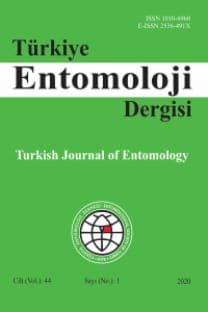Phauloppia lucorum (Koch, 1841)’un karyotip analizi (Oribatida: Oribatulidae)
Acari, holosentrik kromozom, karyotip, Oribatida, Phauloppia lucorum
Karyotype analysis of Phauloppia lucorum (Koch, 1841) (Oribatida: Oribatulidae)
Acari, holocentric chromosome, karyotype, Oribatida, Phauloppia lucorum,
___
- Altınordu, F., L. Peruzzi, Y. Yu & X. J. He, 2016. A tool for the analysis of chromosomes: KaryoType. Taxon, 65: 586-592.
- Ayyıldız, N. & A. Toluk, 2016. Contributions to the Turkish oribatid mite fauna (Acari: Oribatida). Turkish Journal of Entomology, 40 (1): 73-85.
- Behan-Pelletier, V. M., 2015. Sexual dimorphism in Autogneta, with description of three new species from North America and new diagnosis of the genus (Acari, Oribatida, Autognetidae). Zootaxa, 3946 (1): 55-78.
- Chang, M. S., A. Asem & S. C. Sun, 2017. The incidence of rare males in seven parthenogenetic Artemia (Crustacea: Anostraca) populations. Turkish Journal of Zoology, 41: 138-143.
- Eroğlu, H. E., 2015. Which chromosomes are subtelocentric or acrocentric? A new karyotype symmetry/asymmetry index. Caryologia, 68 (3): 239-245.
- Eroğlu, H. E. & S. Per, 2016. Karyotype analysis of Zygoribatula cognata (Oudemans) (Acari: Oribatida: Oribatulidae). Turkish Journal of Entomology, 40 (1): 33-38.
- Gokhman, V. E. & D. L. J. Quicke, 1995. The last twenty years of parasitic Hymenoptera karyology: An update and phylogenetic implications. Journal of Hymenoptera Research, 4: 41-63.
- Gulvik, M. E., 2007. Mites (Acari) as indicators of soil biodiversity and land use monitoring: a review. Polish Journal of Ecology, 55: 415-440.
- Heethoff, M., P. Bergmann & R. A. Norton, 2006. Karyology and sex determination of oribatid mites. Acarologia, 46 (1-2): 127-131.
- Imai, H., R. W. Taylor, M. V. Crosland & R. Crozier, 1988. Modes of spontaneous chromosomal mutation and karyotype evolution in ants with reference to the minimum interaction hypothesis. The Japanese Journal of Genetics, 63 (2): 159-185.
- Lachange, L. E., 1967. “The Induction Dominant Lethal Mutation in Insects by Ionizing Radiation and Chemicals-as Related to the Steril-Male Technique of Insect Control, 617-650”. In: Genetic of Insect Vectors of Diseases (Eds. J. W. Wright & R. Pal). Elsevier, Amsterdam, Netherlands, 794 pp.
- Melters, D. P., L. V. Paliulis, I. F. Korf & S. W. Chan, 2012. Holocentric chromosomes: Convergent evolution, meiotic adaptations, and genomic analysis. Chromosome Research, 20 (5): 579-593.
- North, D. T., 1967. Radiation-Induced male sterility exhibited in the P1 and F1 generations in Lepidoptera. Radiation Research, 31: 615.
- Norton, R. A., J. B. Kethley, D. E. Johnston & B. M. O'Connor, 1993. “Phylogenetic Perspectives on Genetic Systems and Reproductive Odes of Mites, 8-99”. In: Evolution and Diversity of Sex Ratio in Insects and Mites (Eds. D. Wrensch & M. A. Ebbert). Chapman & Hall, New York, USA, 634 pp.
- Oliver, J. H., 1977. Cytogenetics of mites and ticks. Annual Review of Entomology, 22: 407-429.
- Subías, L. S., 2004. Listado sistematico, sinonimico y biogeografico de los acaros oribatidos (Acariformes: Oribatida) del Mundo (Excepte fosiles). Graellsia 60: 3-305 (actualizado en junio de 2006, en abril de 2007, en mayo de 2008, en abril de 2009, en julio de 2010, en febrero de 2011, en abril de 2012, en mayo de 2013 y en febrero de 2014, en marzo de 2015, en febrero de 2016 y en febrero de 2017 y en enero de 2018).
- White, M. J. D., 1973. Animal Cytology and Evolution. Cambridge University Press, London, UK, 468 pp.
- Wrensch, D. L., J. B. Kethley & R. A. Norton, 1994. “Cytogenetics of Holokinetic Chromosomes and Inverted Meiosis: Keys to the Evolutionary Success of Mites, with Generalization on Eukaryotes, 282-343”. In: Mites: Ecological and Evolutionary Analyses of Life-History Patterns (Ed. M. A. Houck). Chapman & Hall, New York, USA, 357 pp.
- ISSN: 1010-6960
- Yayın Aralığı: 4
- Başlangıç: 1977
- Yayıncı: Galip KAŞKAVALCI
Murat ÖLÇÜLÜ, Mustafa ALKAN, Sait ERTÜRK, Fatih ŞEN
Marziyeh CHOUPANIAN, Dzolkhifli OMAR
Phauloppia lucorum (Koch, 1841)’un karyotip analizi (Oribatida: Oribatulidae)
Nisa GÜMÜŞ, Sedat PER, Halil Erhan EROĞLU
Marziyeh CHOUPANIAN, Dzolkhifli OMAR
Abdalla E. T. ADAM, Ertan YANIK, Denis Tange ACHIRI
Sait ERTÜRK, Fatih ŞEN, Mustafa ALKAN, Murat ÖLÇÜLÜ
Murat KÜTÜK, Mehmet YARAN, Ekrem ASLAN, Filiz ÖZBAŞ GERÇEKER
